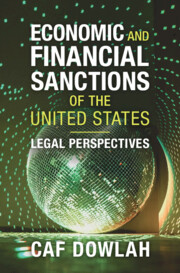Book contents
- Economic and Financial Sanctions of the United States
- Economic and Financial Sanctions of the United States
- Copyright page
- Dedication
- Contents
- Figures
- Tables
- Preface
- Table of Cases
- Table of Statutes and Regulations
- Conventions, Treaties, and Resolutions
- Presidential Executive Orders
- Abbreviations
- 1 Overview of Economic and Financial Sanctions
- 2 Economic and Financial Sanctions under International Law
- 3 Legal Frameworks of US Economic and Financial Sanctions
- 4 Enforcement Infrastructures of US Economic and Financial Sanctions
- 5 US Economic and Financial Sanctions against the Russian Federation
- 6 US Economic and Financial Sanctions against the Islamic Republic of Iran
- 7 US and Multilateral Sanctions Regimes against the Republic of Iraq
- 8 US Economic and Financial Sanctions against the Republic of Cuba
- 9 US Economic and Financial Sanctions against the Bolivarian Republic of Venezuela
- Index
- References
4 - Enforcement Infrastructures of US Economic and Financial Sanctions
Published online by Cambridge University Press: 22 March 2025
- Economic and Financial Sanctions of the United States
- Economic and Financial Sanctions of the United States
- Copyright page
- Dedication
- Contents
- Figures
- Tables
- Preface
- Table of Cases
- Table of Statutes and Regulations
- Conventions, Treaties, and Resolutions
- Presidential Executive Orders
- Abbreviations
- 1 Overview of Economic and Financial Sanctions
- 2 Economic and Financial Sanctions under International Law
- 3 Legal Frameworks of US Economic and Financial Sanctions
- 4 Enforcement Infrastructures of US Economic and Financial Sanctions
- 5 US Economic and Financial Sanctions against the Russian Federation
- 6 US Economic and Financial Sanctions against the Islamic Republic of Iran
- 7 US and Multilateral Sanctions Regimes against the Republic of Iraq
- 8 US Economic and Financial Sanctions against the Republic of Cuba
- 9 US Economic and Financial Sanctions against the Bolivarian Republic of Venezuela
- Index
- References
Summary
This chapter unveils the intricate machinery driving the implementation of US sanctions. The role of US governmental machinery takes center stage as the chapter scrutinizes the sanctions enforcement infrastructures with special focus on the Department of Treasury’s Office of Foreign Assets Control (OFAC), the Department of Commerce’s Bureau of Industry and Security (BIS), and the Department of State’s Bureau of International Security and Non-proliferation (ISN). The chapter also dissects the extraterritorial application of sanctions, unraveling the role of the US dollar-denominated global payments system, and enforcement of US sanctions through mechanisms like SWIFT and the Fedwire Network, while also exploring major challenges posed to this system by emerging alternatives.
Keywords
- Type
- Chapter
- Information
- Economic and Financial Sanctions of the United StatesLegal Perspectives, pp. 117 - 151Publisher: Cambridge University PressPrint publication year: 2025

